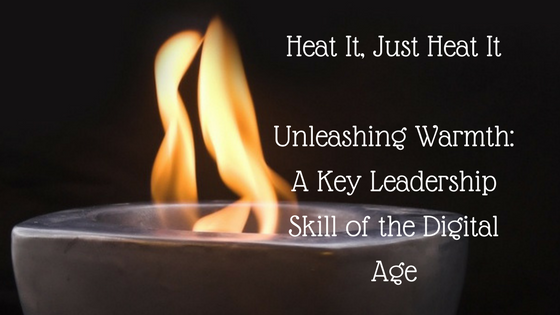Co-authored by Steve Stanton and Frank Wander
In our first article (Link), we discussed the growing impact and significance of automation on employee engagement; in our second (Link), we articulated a theory of HR practices that described a range of temperatures, spanning from cold workplaces where employees are seen as variable costs, to warm ones where employees are embraced as the prime creators of customer and shareholder value.
As Klaus Schwab, founder of the World Economic Forum said, “Talentism, is the new capitalism.” In this digital era people count more than ever. So, understanding how to use human factors as a tool matters to you, your company and your success.
To create warmth in the workplace, we provided a quick mnemonic of the major drivers of engagement today, the 7 T’s (Time, Talent, Tools, Training and Trust, Transparency, and Teamwork) and described the first four, the more extrinsic elements.
In this piece we’ll focus on the final three and discuss how critical these intrinsic motivators are in establishing a durable level of employee engagement. Trust, Transparency, and Teamwork are inextricably linked and enable an organization to move from individual (Me) to collective (We) outcomes.
Building a cohesive culture begins with trust, for without it, individuals focus on personal survival and advantage. Transparency is a vital precursor and enabler of trust because it makes intentions visible. And, lastly, trust enables teams to form and then stay united, so it is best viewed as the social glue that holds teams, organizations and culture together.
Let’s look at how you can use these intrinsic motivators as tools to build a warm, cohesive, motivated and deeply engaged workplace. 
Trust can be defined as the outcome of “doing what you say you’ll do” and “knowing you won’t hurt me”. There are multiple dimensions to trust in organizations, and a detailed description of the three dimensions of trust can be found here (Link).
The Warmth of Trust -> Heat Happens when:
Organizations share pain and gain, as when execs cut their bonuses when layoffs occur
- Individuals feel that their leaders and colleagues “have their back”
- Bad news is shared, not hidden
- Leaders are vulnerable, and admit their weaknesses
- Employees are treated as intelligent adults instead of slow children
- Leadership is actively illuminating the path forward and trusted to lead the organization to a prosperous destination
- Leaders and individuals act with compassion, knowing people are more than their job
- The organization embraces fairness, inclusion, and well-being, creating a workplace that’s safe for everyone
- Executives embrace the wisdom of Campbell Soup’s highly successful CEO, Doug Conant, who said, “To win in the marketplace, you must first win in the workplace.”
Transparency can be defined as the absence of secrets and the prevalence of truth and fairness. While Trust is mostly interpersonal, transparency is a byproduct of your culture. Under the Washington Post’s masthead now reads, “Democracy Dies in Darkness” and so do Trust and Transparency.
The Warmth of Transparency -> Heat Happens when:
- Truth telling is the norm
- Leaders have the courage to provide regular, fact-based feedback
- Work is consistent with the organization’s mission
- Intentions are shared and consistently come true
- Employees understand how the business operates and how their work fits within the entire flow
- Open workspaces are plentiful
- Pay equity is provided
- Compensation, the third rail of organizations, is fair and linked with outcomes, not politics
- Hidden agendas are culturally unacceptable
- Individuals who lack transparency feel the discomfort of being a cultural misfit, and leave or are forced out
- The workplace shuns the corrosive effects of secrecy and secret dealings, because as the Dalai Lama noted, “A lack of transparency results in distrust and a deep sense of insecurity.”
Teamwork is all about collaboration and cooperation.
With Trust and Transparency in place, high performing teams can achieve remarkable results.
The Warmth of Teamwork -> Heat Happens when:
- No employee is an island
- Workers feel a deep sense of belonging
- Functional silos are aggressively eliminated
- Front line employees are the primary source of improvement ideas
- Workers are included and consulted about decisions that impact their area of responsibility
- Cross functional collaboration is routine
- People erect bridges instead of walls
- Employees understand what other employees do
- People at all levels respect one another
- People are treated as equals such that the equality can be felt
- There’s a common definition of success
- Meetings operate effectively
- Workers at every level understand Patrick Lencioni’s observation: “Remember, teamwork begins by building trust. And the only way to do that is to overcome our need for invulnerability.”
Unlike other elements of engagement, these three cannot be faked. Only sincerity will work. This happens because humans are deeply wired for fairness, as are most social organisms. This short Ted video, illustrates how deeply this basic human needs is wired into our social psyche (Link). The research is very clear, humans deeply feel a lack of trust, transparency and teamwork, and become very uncomfortable in the workplace if these are not cultural norms.
If the 7 T’s are lived at all levels of your culture, you will be on your way to building a truly high performing culture that can design and deliver the digital transformation that is now so fundamental to corporate survival. Happy travels!
About Steve Stanton
Steve is the author of the recently published book, “Smart Work: Why Organizations Full of Intelligent People Do So Many Dumb Things and What You Can Do About It.” He is a pioneer of process innovation. For thirty years his work has been focused on improving the capability of organizations to transform themselves. Mr. Stanton is also the co-author, with Dr. Hammer, of “The Reengineering Revolution” (HarperBusiness) and the Harvard Business Review article “How Process Organizations Really Work.” Mr. Stanton holds an MBA from Harvard and a BA from the Berklee School of Music.
About Frank Wander
Frank Wander, a former turnaround CIO, is founder and CEO of PeopleProductive (peopleproductive.com), a workforce productivity company that helps customers get the best out of their people. PeopleProductive is Talent Management Reimagined®.
He is also the author of Transforming IT Culture: How to Use Social Intelligence, Human Factors and Collaboration to Create an IT Department That Outperforms (Wiley Publishing). This unique book is the very first operator’s manual for the human infrastructure, and will help you successfully transform your leadership style and your organization.
A message from the PeopleProductive team:
We're thrilled to have your interest in our work and we invite you to join our mission of creating work places where the people as well as the company, both flourish. We welcome your support and participation. To find out more about this just reach out to us here!"


